Study on the Strength and Failure Characteristics of Silty Mudstone Using Different Unloading Paths
Abstract
:1. Introduction
2. Materials
2.1. Specimens Preparation
2.2. Test Apparatus
3. Test Methods
4. Test Results and Discussions
4.1. Stress Path I
4.2. Stress Path II
4.3. Effect of Stress Path on Strength
5. Analysis of Macroscopic Characteristics of Specimens after Unloading Failure
5.1. Stress Path I
5.2. Stress Path II
6. Conclusions
- Under constant initial deviatoric stress and varying confining pressures, the silt-like mudstone exhibited continuous increases in peak stress, residual stress, and elastic modulus as the initial confining pressure increased during the unloading process. The peak strain and residual strain initially decreased gradually with the increase in initial confining pressure, subsequently displaying a notable increase before eventually decreasing. Additionally, the unloading damage time and unloading strain rate were found to be negatively correlated with the increase in confining pressure.
- Under different initial deviatoric stress conditions, the peak stress, residual stress, and residual strain under unloading confining pressure conditions exhibited a decreasing trend with an increase in initial deviatoric stress. The peak strain and elastic modulus initially demonstrated an increasing trend, followed by a subsequent decline, with an increase in initial deviatoric stress. Conversely, the unloading failure time and unloading strain rate decreased as the initial deviatoric stress increased.
- To characterize the shear strength variation of specimens, the cohesion and internal friction angle were obtained in accordance with the Mohr stress circle, the values of which were relatively close when both unloading stress path I and path II were used. Path I exhibited a larger cohesive force than path II, whereas the internal friction angle showed the opposite trend.
- The failure mechanism observed during the unloading of the specimens was characterized by a collapse-type failure, which may be primarily attributed to lateral expansion induced by the applied unloading confining pressure. The fractured surface predominantly exhibited shear failure. During the unloading process, when subjected to low initial confining pressure and low deviatoric stress conditions, the evolution of tension cracks was not prominently observed, and the specimens exhibited a high level of structural integrity. Conversely, under high initial confining pressure and high deviatoric stress conditions, the macroscopic development of cracks became more pronounced, leading to a greater degree of specimen fragmentation. Additionally, the end failure of the specimen became more evident.
Author Contributions
Funding
Institutional Review Board Statement
Informed Consent Statement
Data Availability Statement
Conflicts of Interest
References
- Omar, H.; Rod, S.; David, R. A study of the effect of strain rate on stiffness and strength in silty mudstone using multistage triaxial testing. Post-Min. 2005, 2005, 16–17. [Google Scholar]
- Corkum, A.G.; Martin, C.D. The Mechanical Behaviour of Weak Mudstone (Opalinus Clay) at Low Stresses. Int. J. Rock Mech. Min. Sci. 2007, 44, 196–209. [Google Scholar] [CrossRef]
- Taheri, A.; Tani, K. Use of Down-Hole Triaxial Apparatus to Estimate the Mechanical Properties of Heterogeneous Mudstone. Int. J. Rock Mech. Min. Sci. 2008, 45, 1390–1402. [Google Scholar] [CrossRef]
- Fu, H.; Jiang, H.; Qiu, X.; Ji, Y.; Chen, W.; Zeng, L. Seepage Characteristics of a Fractured Silty Mudstone under Different Confining Pressures and Temperatures. J. Cent. South Univ. 2020, 27, 1907–1916. [Google Scholar] [CrossRef]
- Huang, X.; Wang, L.; Ye, R.; Yi, W.; Huang, H.; Guo, F.; Huang, G. Study on Deformation Characteristics and Mechanism of Reactivated Ancient Landslides Induced by Engineering Excavation and Rainfall in Three Gorges Reservoir Area. Nat. Hazards 2022, 110, 1621–1647. [Google Scholar] [CrossRef]
- Jian, W.; Wang, Z.; Yin, K. Mechanism of the Anlesi Landslide in the Three Gorges Reservoir, China. Eng. Geol. 2009, 108, 86–95. [Google Scholar] [CrossRef]
- Xie, H.; Liu, Z.; Wen, G.; Chen, H.; Yang, Y. Influencing factors of landslides and rockfalls along the Jinchuan-Xiaojin highway in Sichuan. Chin. J. Geol. Hazard Control 2021, 32, 10–17. [Google Scholar] [CrossRef]
- Wang, J.-J.; Liu, M.-N.; Jian, F.-X.; Chai, H.-J. Mechanical Behaviors of a Sandstone and Mudstone under Loading and Unloading Conditions. Environ. Earth Sci. 2019, 78, 30. [Google Scholar] [CrossRef]
- Wang, Y.; Feng, W.K.; Hu, R.L.; Li, C.H. Fracture Evolution and Energy Characteristics During Marble Failure Under Triaxial Fatigue Cyclic and Confining Pressure Unloading (FC-CPU) Conditions. Rock Mech. Rock Eng. 2021, 54, 799–818. [Google Scholar] [CrossRef]
- Zhang, Y.; Yang, Y.; Ma, D. Mechanical Characteristics of Coal Samples under Triaxial Unloading Pressure with Different Test Paths. Shock Vib. 2020, 2020, e8870821. [Google Scholar] [CrossRef]
- Takeda, M.; Manaka, M. Effects of Confining Stress on the Semipermeability of Siliceous Mudstones: Implications for Identifying Geologic Membrane Behaviors of Argillaceous Formations. Geophys. Res. Lett. 2018, 45, 5427–5435. [Google Scholar] [CrossRef]
- Zhang, Z.; Yu, X.; Deng, M. Damage Evolution of Sandy Mudstone Mechanical Properties Under Mining Unloading Conditions in Gob-Side Entry Retaining. Geotech. Geol. Eng. 2019, 37, 3535–3545. [Google Scholar] [CrossRef]
- Guo, Y.; Wang, L.; Chang, X. Study on the Damage Characteristics of Gas-Bearing Shale under Different Unloading Stress Paths. PLoS ONE 2019, 14, e0224654. [Google Scholar] [CrossRef] [PubMed]
- Hajiabdolmajid, V.; Kaiser, P.K.; Martin, C.D. Modelling Brittle Failure of Rock. Int. J. Rock Mech. Min. Sci. 2002, 39, 731–741. [Google Scholar] [CrossRef]
- Xiao, F.; Jiang, D.; Wu, F.; Zou, Q.; Chen, J.; Chen, B.; Sun, Z. Effects of Prior Cyclic Loading Damage on Failure Characteristics of Sandstone under True-Triaxial Unloading Conditions. Int. J. Rock Mech. Min. Sci. 2020, 132, 104379. [Google Scholar] [CrossRef]
- Huang, D.; Li, Y. Conversion of Strain Energy in Triaxial Unloading Tests on Marble. Int. J. Rock Mech. Min. Sci. 2014, 66, 160–168. [Google Scholar] [CrossRef]
- Zhao, Y.; Cao, P.; Wang, W.; Wan, W.; Liu, Y. Viscoelasto-Plastic Rheological Experiment under Circular Increment Step Load and Unload and Nonlinear Creep Model of Soft Rocks. J. Cent. South Univ. Technol. 2009, 16, 488–494. [Google Scholar] [CrossRef]
- Chen, X.; Tang, C.; Yu, J.; Zhou, J.; Cai, Y. Experimental Investigation on Deformation Characteristics and Permeability Evolution of Rock under Confining Pressure Unloading Conditions. J. Cent. South Univ. 2018, 25, 1987–2001. [Google Scholar] [CrossRef]
- Gupta, N.; Mishra, B. Experimental Investigation of the Influence of Bedding Planes and Differential Stress on Microcrack Propagation in Shale Using X-ray CT Scan. Geotech. Geol. Eng. 2021, 39, 213–236. [Google Scholar] [CrossRef]
- Dai, B.; Zhao, G.; Dong, L.; Yang, C. Mechanical Characteristics for Rocks under Different Paths and Unloading Rates under Confining Pressures. Shock Vib. 2015, 2015, e578748. [Google Scholar] [CrossRef]
- Zhang, L.; Gao, S.; Wang, Z.; Ren, M. Analysis on deformation characteristics and energy dissipation of marble under different unloading rates. Teh. Vjesn. 2014, 21, 987–993. [Google Scholar]
- Cerfontaine, B.; Collin, F. Cyclic and Fatigue Behaviour of Rock Materials: Review, Interpretation and Research Perspectives. Rock Mech. Rock Eng. 2018, 51, 391–414. [Google Scholar] [CrossRef]
- Jiang, C.; Wang, L.; Ding, K.; Wang, S.; Ren, B.; Guo, J. Experimental Study on Mechanical and Damage Evolution Characteristics of Coal during True Triaxial Cyclic Loading and Unloading. Materials 2023, 16, 2384. [Google Scholar] [CrossRef] [PubMed]
- Munoz, H.; Taheri, A. Local Damage and Progressive Localisation in Porous Sandstone During Cyclic Loading. Rock Mech. Rock Eng. 2017, 50, 3253–3259. [Google Scholar] [CrossRef]
- Wang, J.; Shi, Z.; Zeng, L.; Qi, S. The Effects of Different Nanoadditives on the Physical and Mechanical Properties of Similar Silty Mudstone Materials. Adv. Civ. Eng. 2020, 2020, e8850436. [Google Scholar] [CrossRef]
- Fu, H.; Qi, S.; Shi, Z.; Zeng, L.; Zhao, H. Effect of Nano-CaCO3 on the Physical and Mechanical Properties of Analogue to Silty Mudstone Materials. Arab. J. Geosci. 2021, 14, 2502. [Google Scholar] [CrossRef]
- Fu, H.; Qi, S.; Shi, Z.; Zeng, L. Mixing Ratios and Cementing Mechanism of Similar Silty Mudstone Materials for Model Tests. Adv. Civ. Eng. 2021, 2021, e2426130. [Google Scholar] [CrossRef]
- Bustamante, J.G. ASTM D2845. Standard Test Method for Laboratory Determination of Pulse Velocities and Ultra sonic Elastic Constants of Rock. Retrieved July 11, 2023. Available online: https://www.academia.edu/18991867/ASTM_D2845 (accessed on 21 June 2023).
- Arzúa, J.; Alejano, L.R.; Walton, G. Strength and Dilation of Jointed Granite Specimens in Servo-Controlled Triaxial Tests. Int. J. Rock Mech. Min. Sci. 2014, 69, 93–104. [Google Scholar] [CrossRef]
- Abi, E.; Yuan, H.; Cong, Y.; Wang, Z.; Jiang, M. Experimental Study on the Entropy Change Failure Precursors of Marble under Different Stress Paths. KSCE J. Civ. Eng. 2023, 27, 356–370. [Google Scholar] [CrossRef]
- Brown, E.T.; Trollope, D.H. Strength of a Model of Jointed Rock. J. Soil Mech. Found. Div. 1970, 96, 685–704. [Google Scholar] [CrossRef]
- Lundborg, N. Strength of Rock-like Materials. Int. J. Rock Mech. Min. Sci. Geomech. Abstr. 1968, 5, 427–454. [Google Scholar] [CrossRef]
- Gong, F.; Luo, S.; Lin, G.; Li, X. Evaluation of Shear Strength Parameters of Rocks by Preset Angle Shear, Direct Shear and Triaxial Compression Tests. Rock Mech. Rock Eng. 2020, 53, 2505–2519. [Google Scholar] [CrossRef]
- Taheri, A.; Squires, J.; Meng, Z.; Zhang, Z. Mechanical Properties of Brown Coal under Different Loading Conditions. Int. J. Geomech. 2017, 17, 06017020. [Google Scholar] [CrossRef]
- Yin, G.; Jiang, C.; Wang, J.G.; Xu, J. Geomechanical and Flow Properties of Coal from Loading Axial Stress and Unloading Confining Pressure Tests. Int. J. Rock Mech. Min. Sci. 2015, 76, 155–161. [Google Scholar] [CrossRef]
- Li, J.; Lin, F.; Liu, H.; Zhang, Z. Triaxial Experimental Study on Changes in the Mechanical Properties of Rocks Under Different Rates of Confining Pressures Unloading. Soil Mech. Found. Eng. 2019, 56, 246–252. [Google Scholar] [CrossRef]
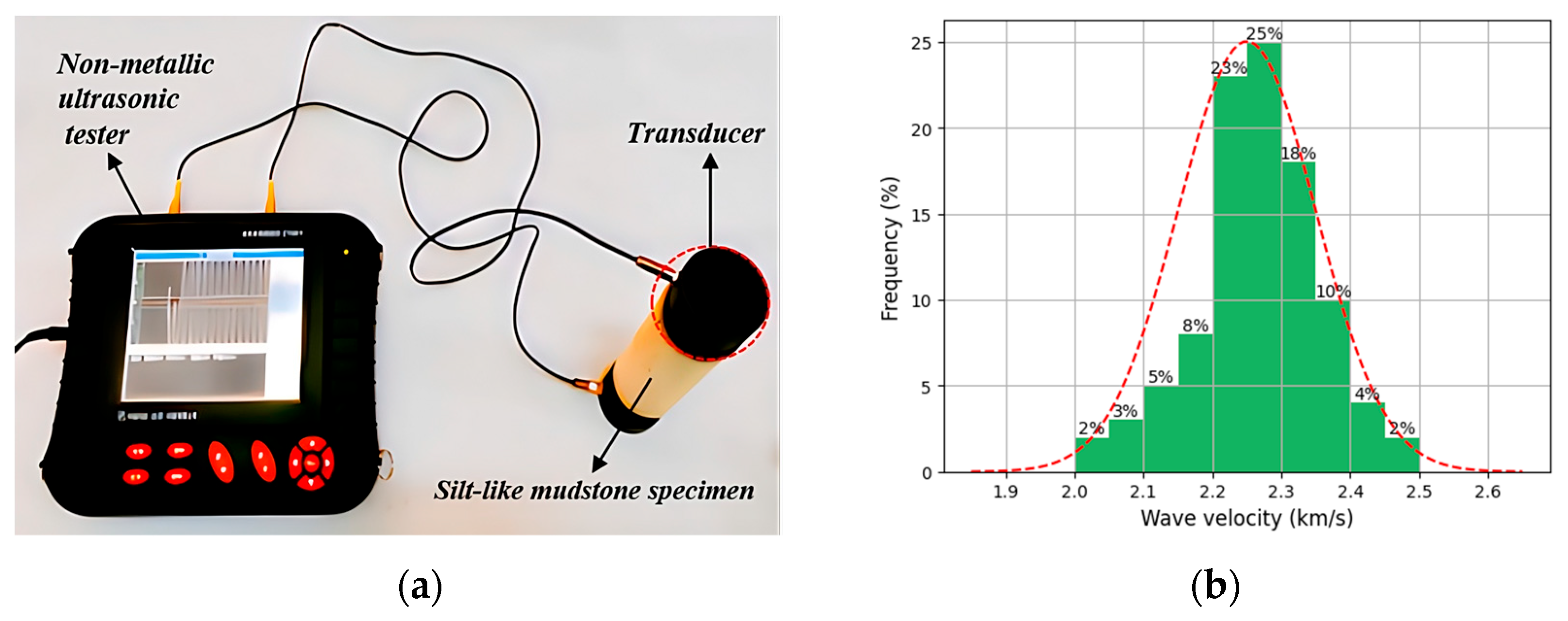
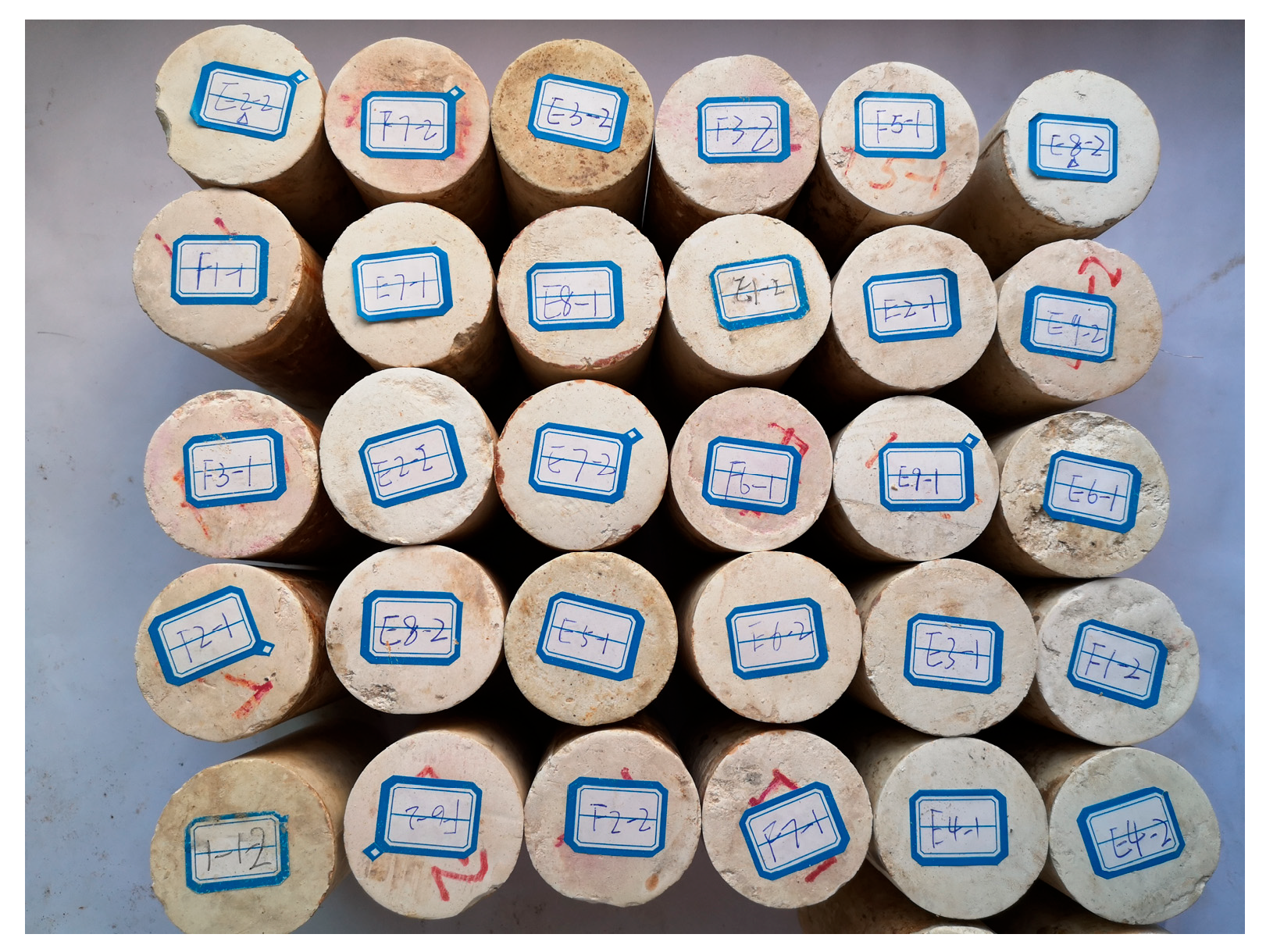
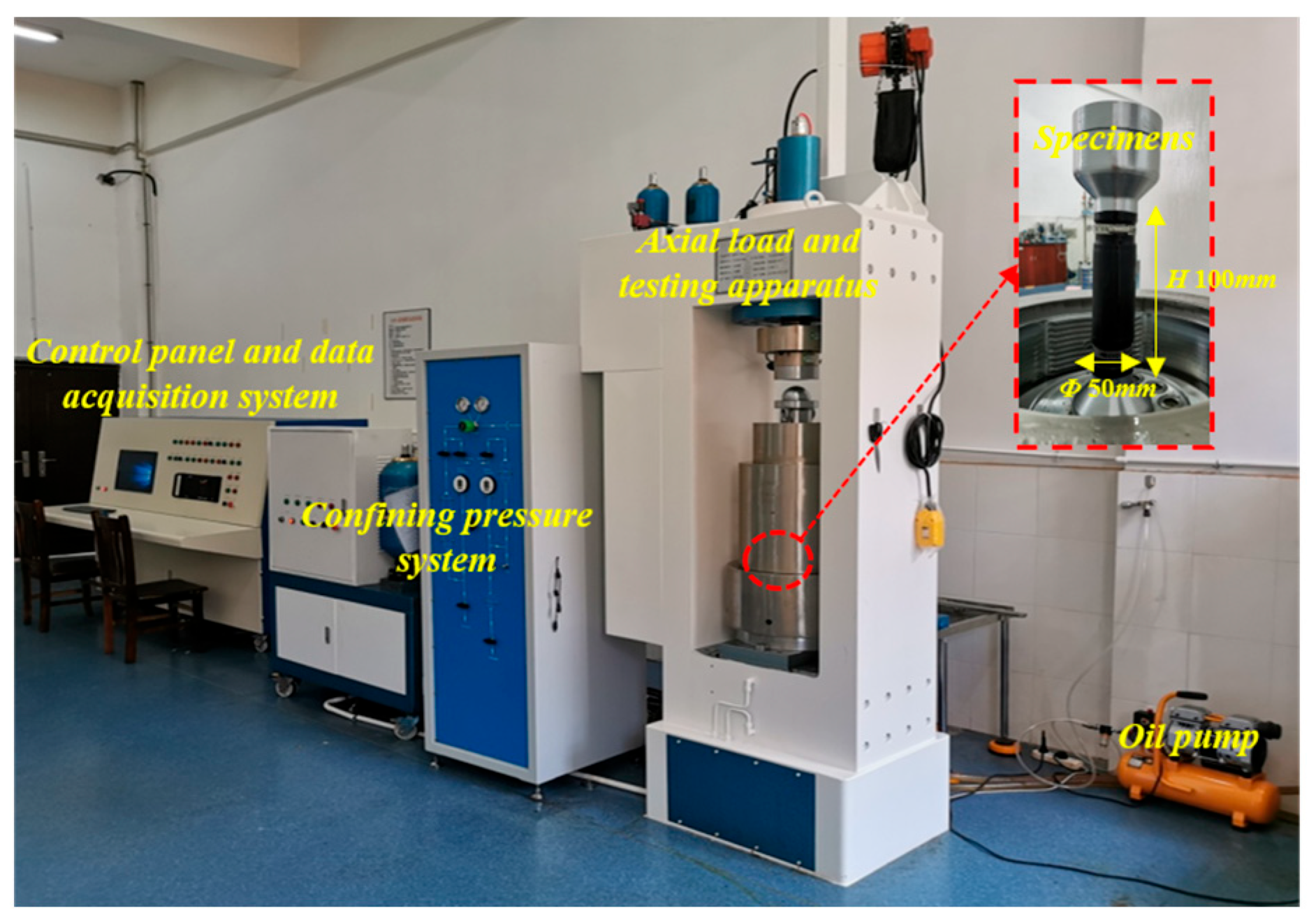
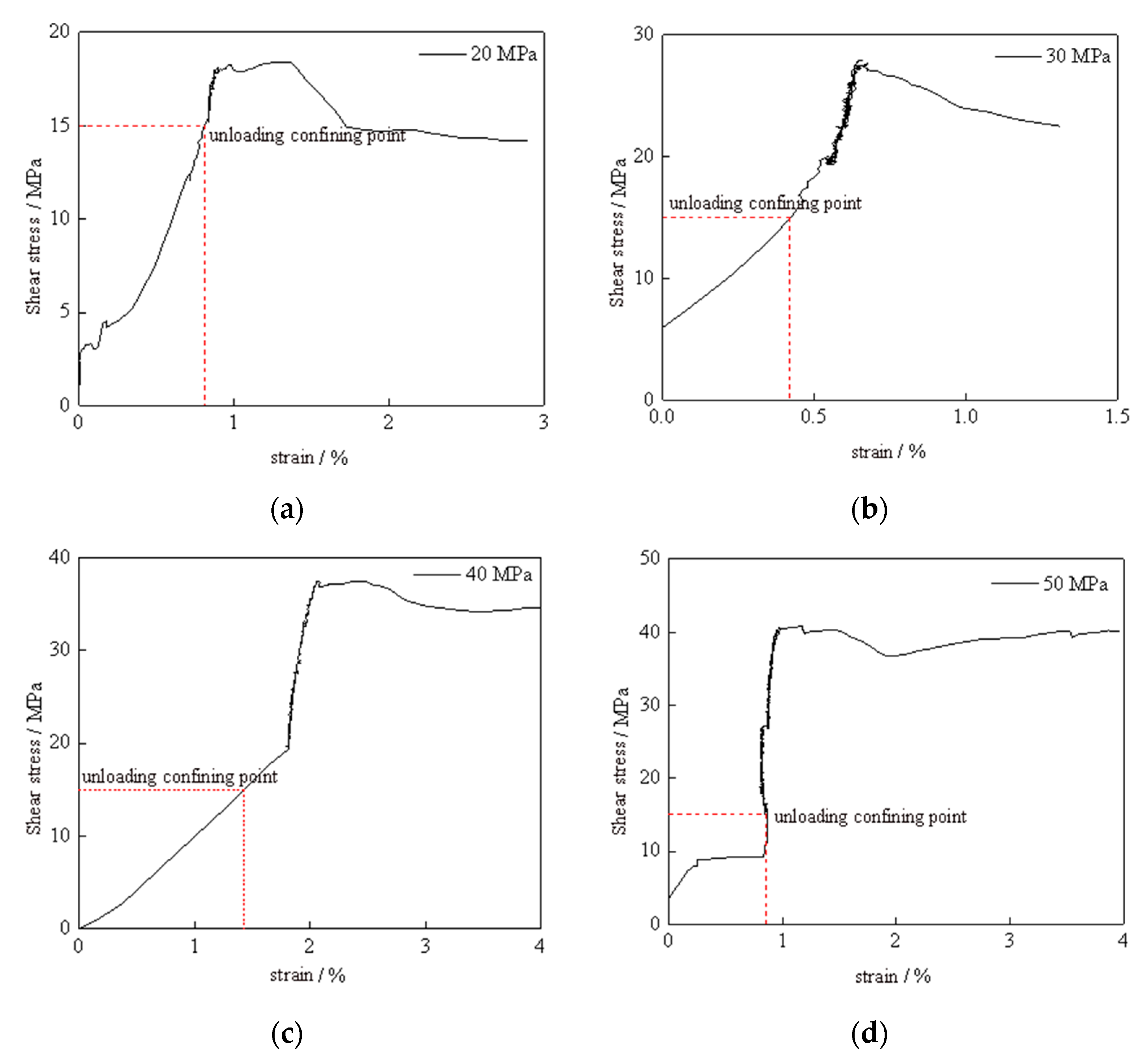
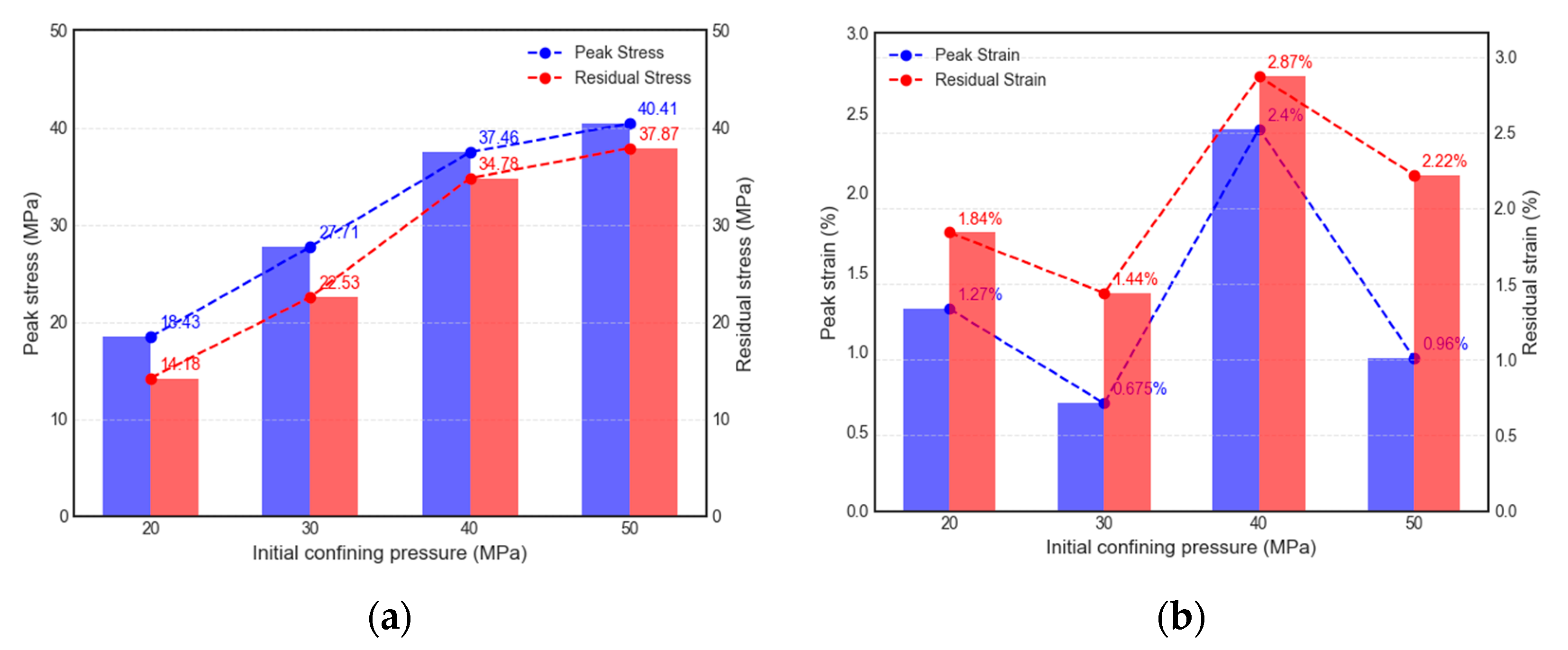
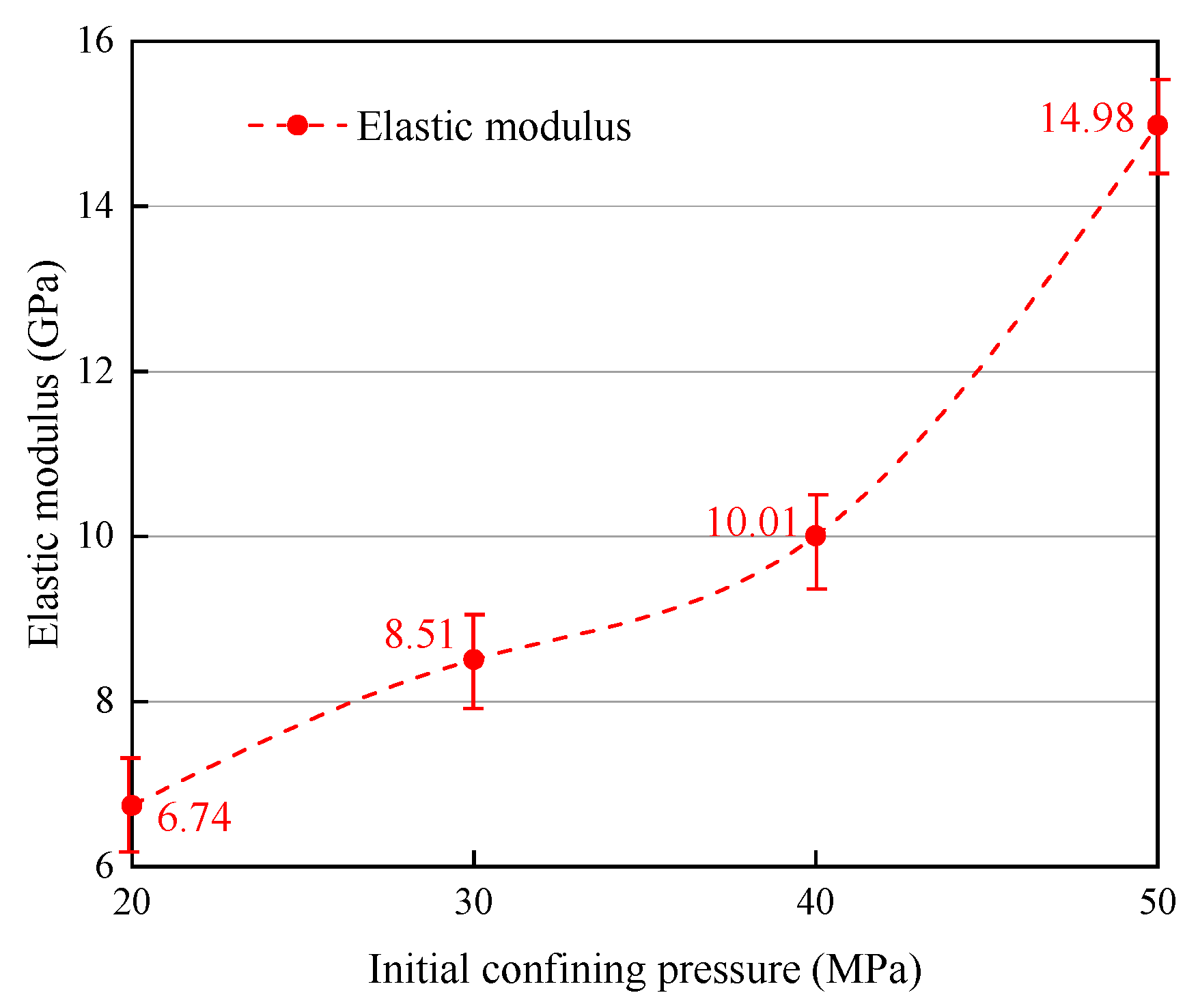
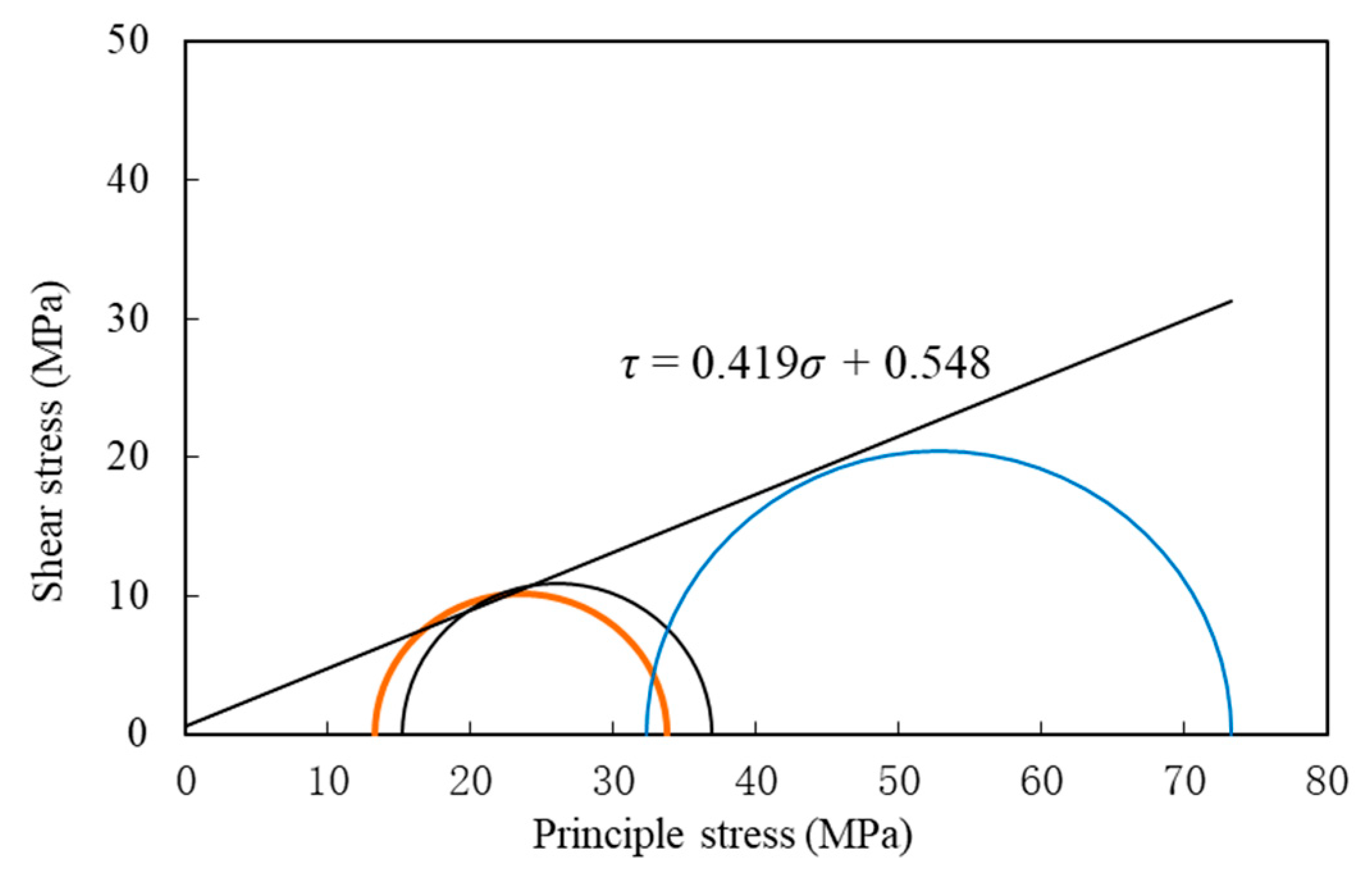
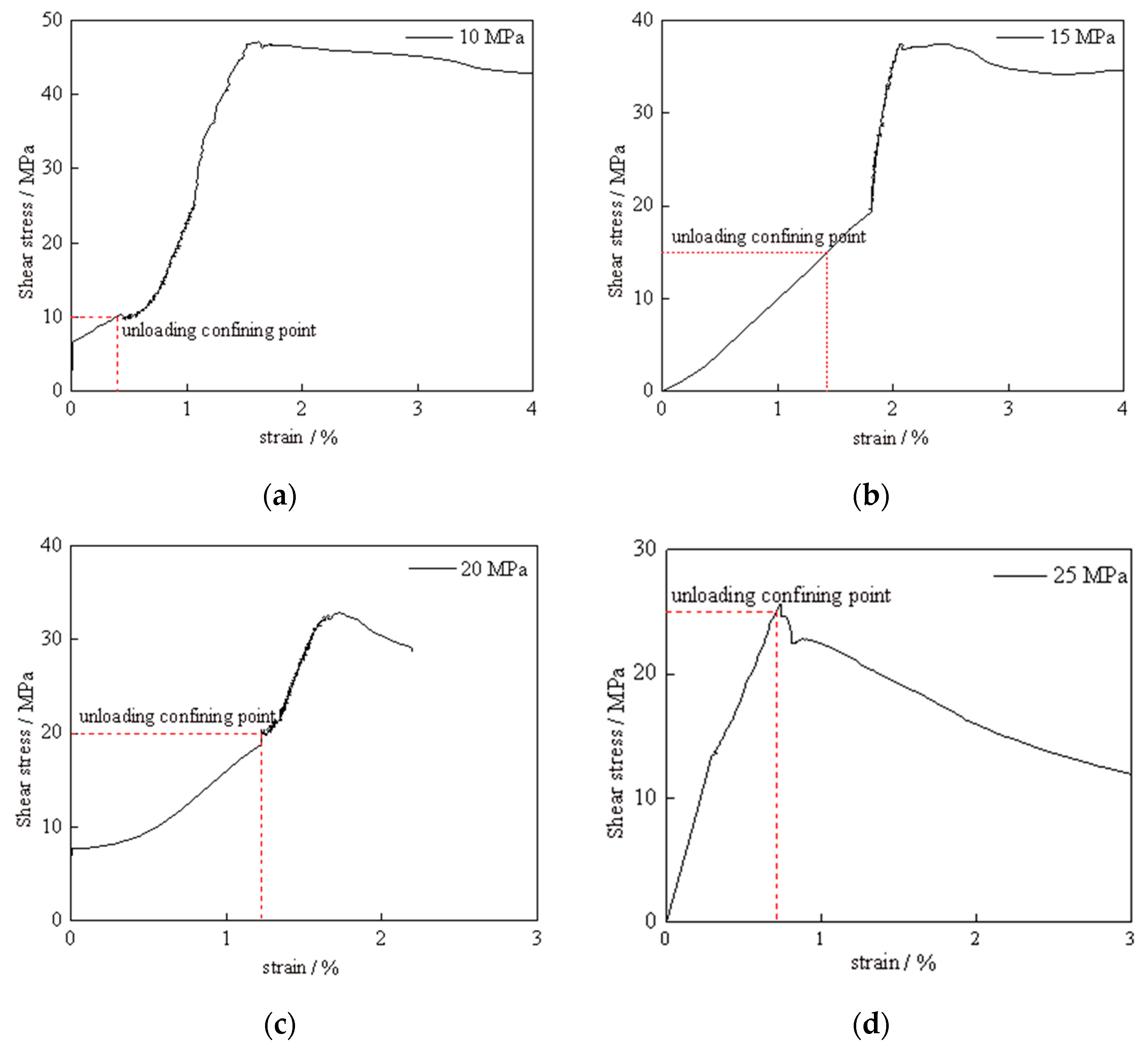
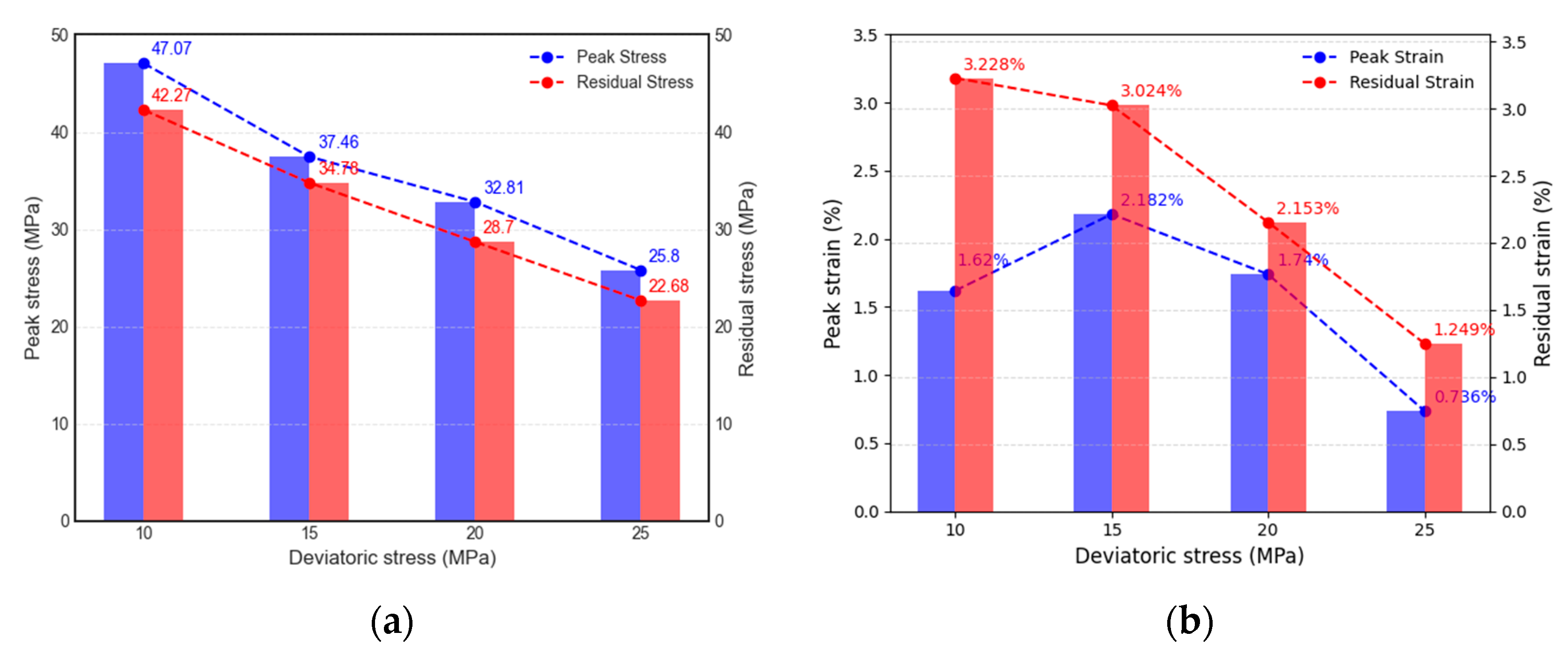
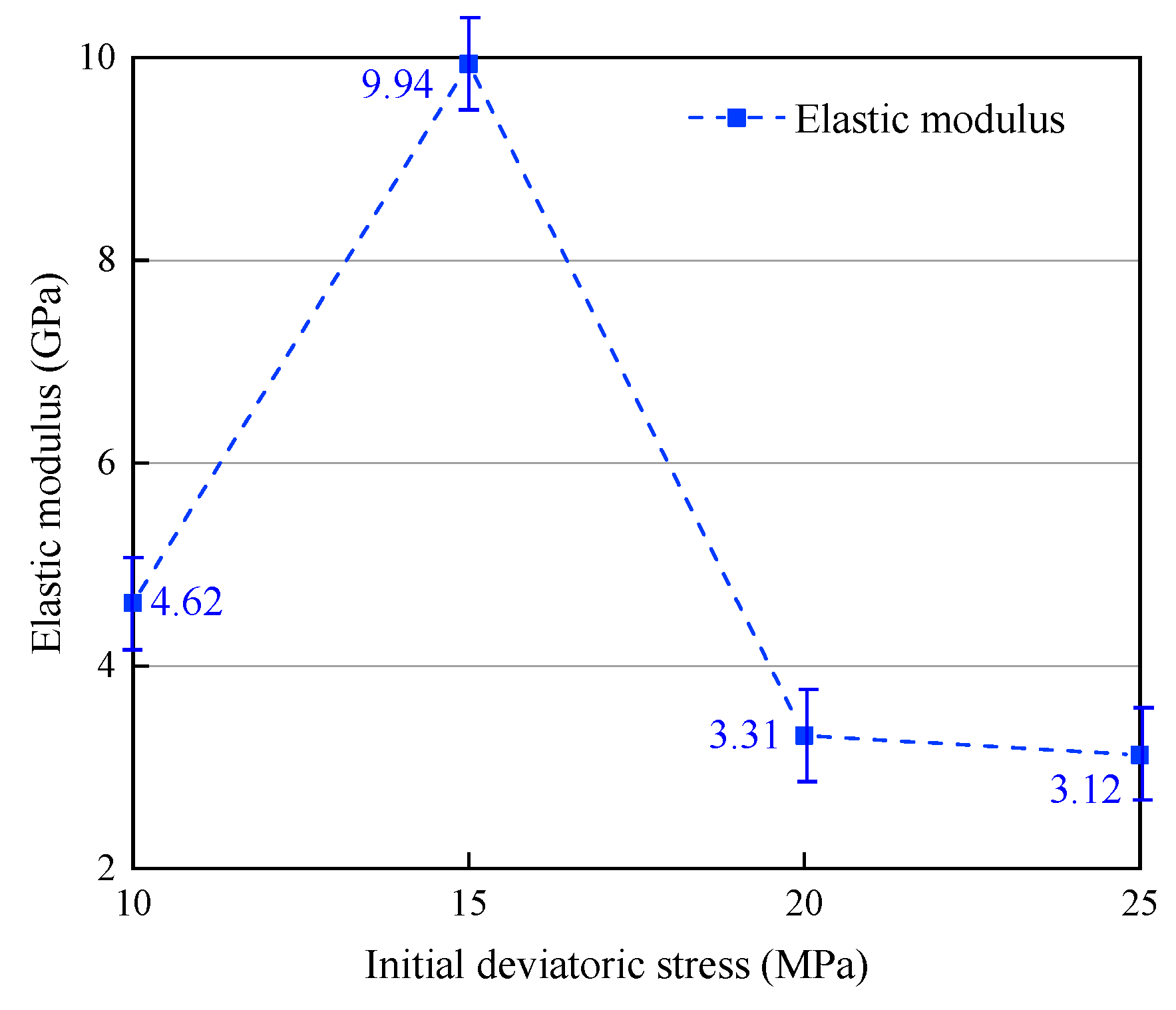
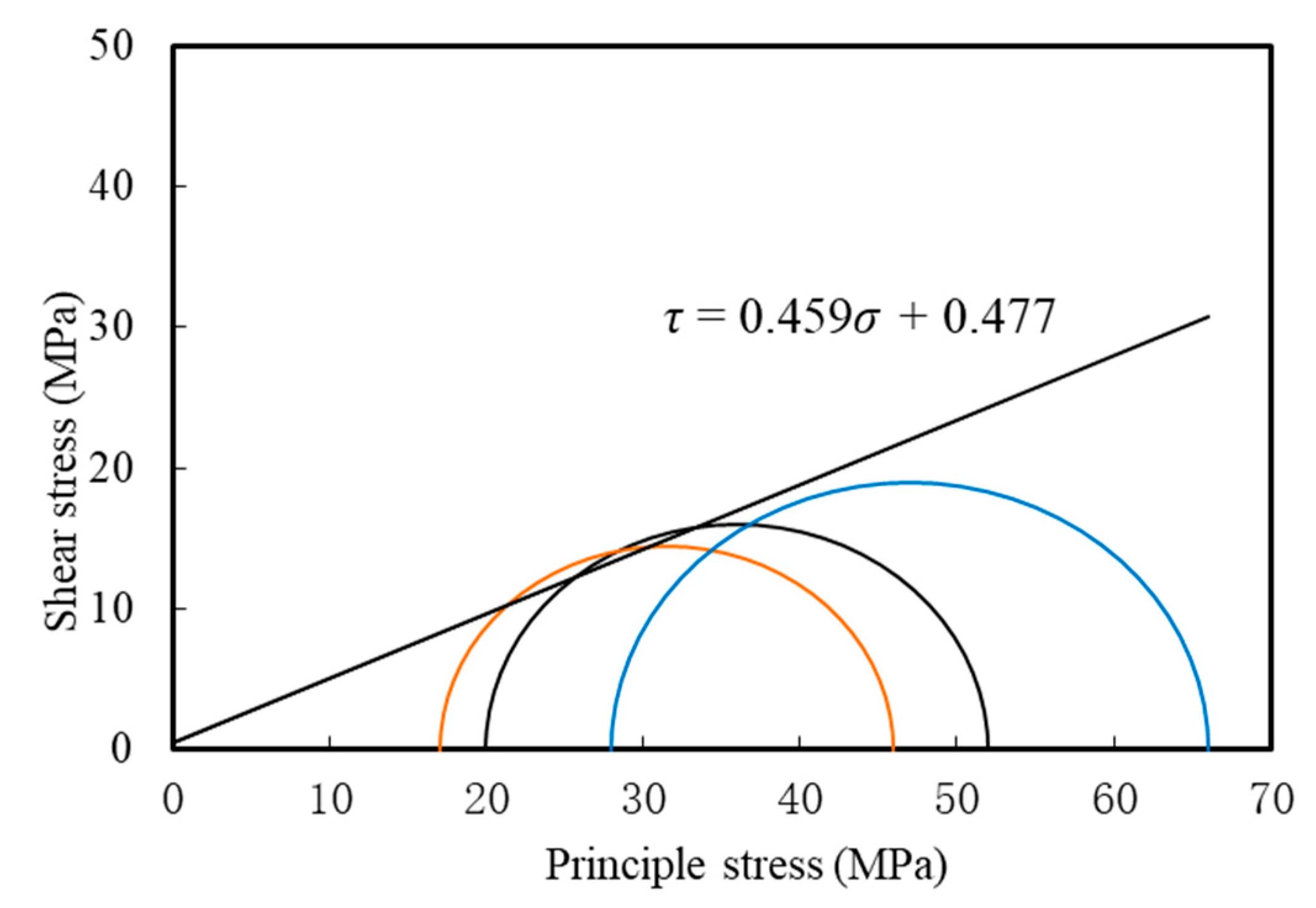
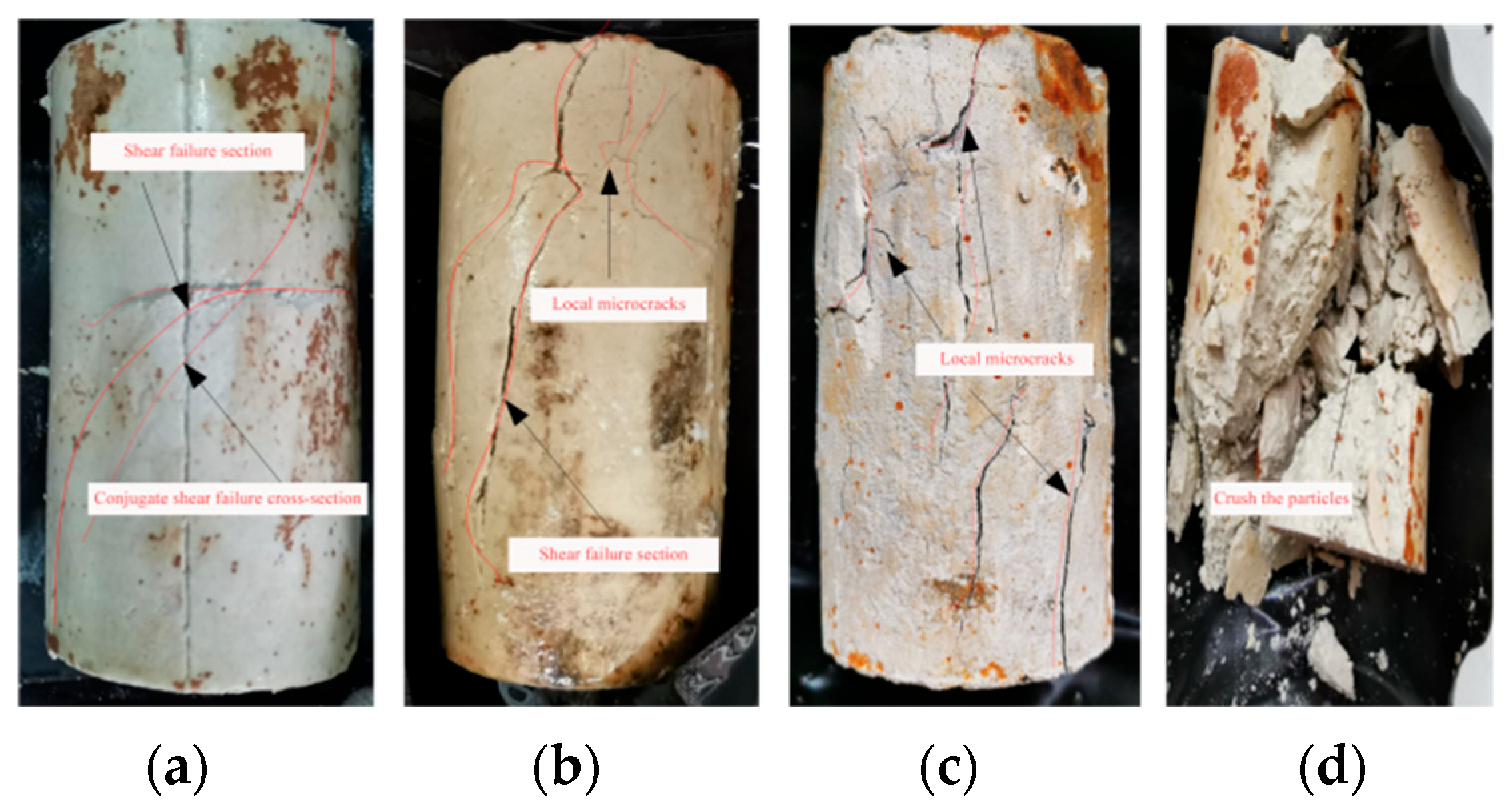
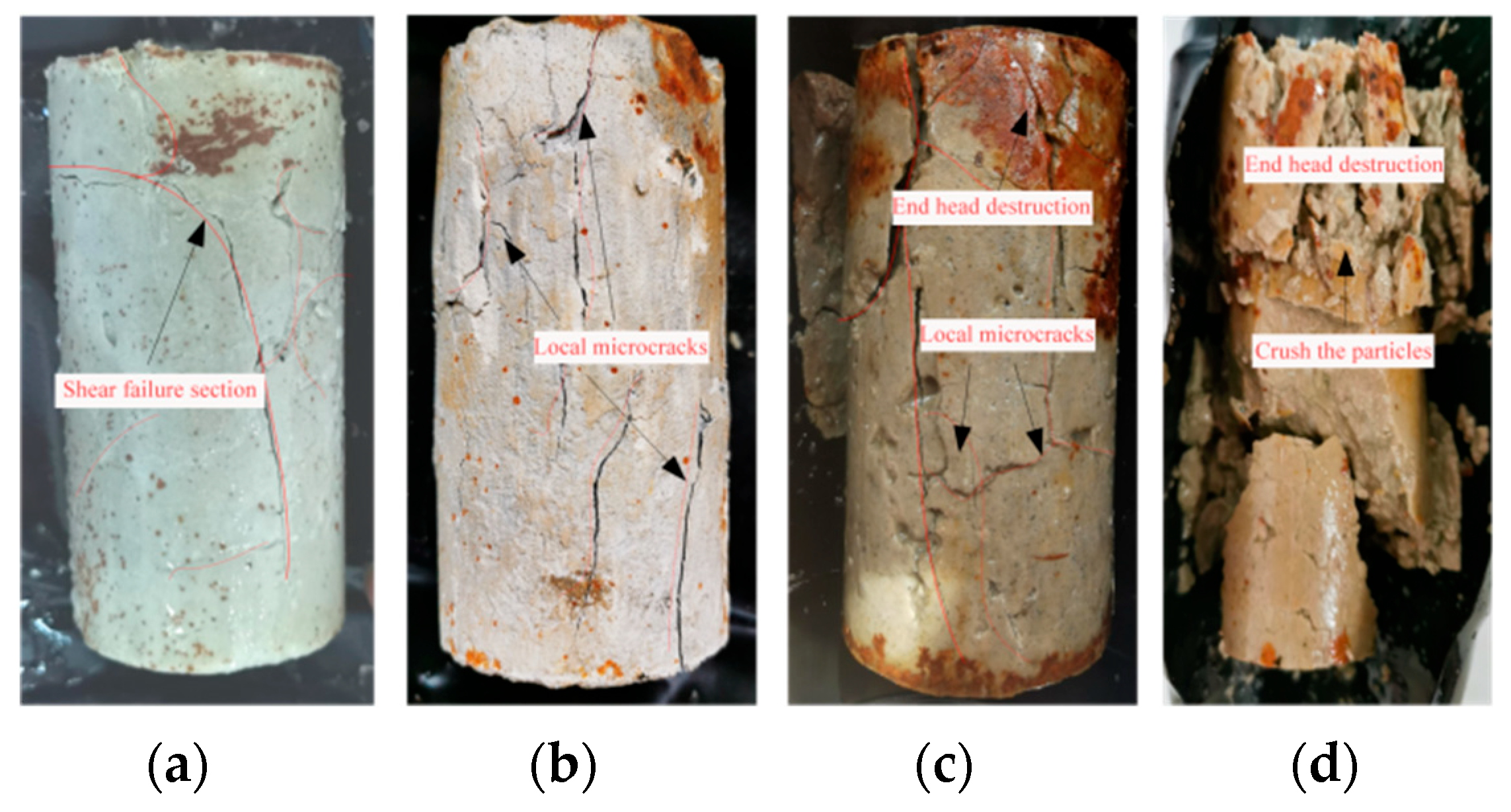
| Parameters | Density (g/cm3) | Water Absorption Rate (%) | Swelling Rate (%) | Longitudinal Wave Speed (km/s) | Uniaxial Strength (MPa) | Tensile Strength (MPa) | Softening Coefficient |
|---|---|---|---|---|---|---|---|
| Original rock | 2.15–2.34 | 2.14–8.16 | 0.14–0.18 | 1.75–2.85 | 6.9–23.8 | 0.3–1.4 | 0.4–0.66 |
| Specimens | 2.26 | 6.05 | 0.15 | 2.20–2.30 | 8.15 | 1.38 | 0.56 |
| Path Number | Axial Pressure σ1 (MPa) | Confining Pressure σ3 (MPa) | Deviatoric Stress σ1–σ3 (MPa) | Axial Pressure after Damage (MPa) | Confining Pressure σ3 (MPa) | |
|---|---|---|---|---|---|---|
| Path I | I-1 | 35 | 20 | 15 | 35 | 0.075 MPa/s unloading rate until damage |
| I-2 | 45 | 30 | 45 | |||
| I-3 | 55 | 40 | 55 | |||
| I-4 | 65 | 50 | 65 | |||
| Path II | II-1 | 50 | 40 | 10 | 50 | 0.075 MPa/s unloading rate until damage |
| II-2 | 55 | 15 | 55 | |||
| II-3 | 60 | 20 | 60 | |||
| II-4 | 65 | 25 | 65 | |||
| Stress Path | Cohesion c (MPa) | Internal Friction Angle φ (°) | Correlation Coefficient R2 |
|---|---|---|---|
| Unloading path I | 0.548 | 26.151 | 0.983 |
| Unloading path II | 0.477 | 26.335 | 0.968 |
Disclaimer/Publisher’s Note: The statements, opinions and data contained in all publications are solely those of the individual author(s) and contributor(s) and not of MDPI and/or the editor(s). MDPI and/or the editor(s) disclaim responsibility for any injury to people or property resulting from any ideas, methods, instructions or products referred to in the content. |
© 2023 by the authors. Licensee MDPI, Basel, Switzerland. This article is an open access article distributed under the terms and conditions of the Creative Commons Attribution (CC BY) license (https://creativecommons.org/licenses/by/4.0/).
Share and Cite
Wang, J.; Zhang, H.; Qi, S.; Bian, H.; Long, B.; Duan, X. Study on the Strength and Failure Characteristics of Silty Mudstone Using Different Unloading Paths. Materials 2023, 16, 5155. https://doi.org/10.3390/ma16145155
Wang J, Zhang H, Qi S, Bian H, Long B, Duan X. Study on the Strength and Failure Characteristics of Silty Mudstone Using Different Unloading Paths. Materials. 2023; 16(14):5155. https://doi.org/10.3390/ma16145155
Chicago/Turabian StyleWang, Jijing, Hualin Zhang, Shuangxing Qi, Hanbing Bian, Biao Long, and Xinbo Duan. 2023. "Study on the Strength and Failure Characteristics of Silty Mudstone Using Different Unloading Paths" Materials 16, no. 14: 5155. https://doi.org/10.3390/ma16145155
APA StyleWang, J., Zhang, H., Qi, S., Bian, H., Long, B., & Duan, X. (2023). Study on the Strength and Failure Characteristics of Silty Mudstone Using Different Unloading Paths. Materials, 16(14), 5155. https://doi.org/10.3390/ma16145155






